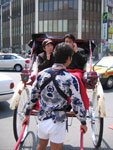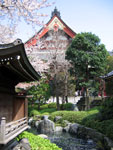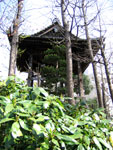Sensoji Temple
Well, this is basically a continuation of the previous entry. After brunch, I decided to go to Sensoji Temple (Asakusa Kannon Temple). I started by going into the front of Kaminarimon Gate. Since this was on Sunday, the place was packed full of tourists. There are also these rickshaw drivers trying to offer people a ride on their carriage. I’ve seen this on Japanese Drama but I never thought that there really are rickshaw drivers in Japan. Anyway, Kaminarimon Gate is basically an entrance to the Nakamise shopping arcade and of course, the Sensoji temple itself.
Once you past the gate, you basically will see rows of traditional shops lining up from the start of the gate to the front of the temple. These shops sell many things including Foods, Kimono, Sweets, Biscuits, and other types of souvenirs to take home. Like I said on my previous entry, I had to restraint myself from buying anything because I’d travel to Central Japan and possibly elsewhere so it wasn’t a good idea to buy too much things at this point in time. In the end, all that I bought was a pack of Kibidango. After 5-10 minutes of continuous shops, I ended up in front of Sensoji-temple.
The first thing that I did was washing both of my hands in a fountain underneath the general statue. To be honest, I wasn’t sure if this was a requirement of entering the temple. But everyone else did it and I didn’t want to be the only one who breaks the rule and offends someone. Anyway, a bit of history here, Asakusa Kannon Temple is basically named after the Kannon/the Goddess of Mercy. The inside of the temple is heavily decorated. Unfortunately, there is some kind of bar that separates the visitors from the altar, so I couldn’t take a good picture of the altar.
There’s also this place where you can throw coins and wish for something. I can’t remember what I wished for but I sure hope it will come true :D. Anyway, the top of the ceiling contains these two paintings that alternate with each other. One of the painting is that of a Goddess, and the other is a dragon. Both are equally impressive and I kept wondering what kind of back pain the painter must endured during the creation of these work of art. Anyway, apart from the temple, there is also a shrine built based on the order of the 3rd Tokugawa Shogun to commemorate the 3 fishermen and a very zen-like park.
Some of the highlight of the park includes: a statue of Buddha, a tranquil pond complete with Koi fish, Sakura petals flying all over as one passes the park, a cute bird house, and a Spring festival around the park. I have to say that I’ve been enjoying this particular temple. I know that some part of it sounds really commercial (the store stalls, etc). Having said that, it’s such a minor part that I don’t think it’ll ruin the entire experience of visiting the temple itself.
6 comments6 Comments so far
Leave a reply
















Heheh, that looks like fun ^^ Though a bit crowded… = =,,
Menouthis-san, I’ve been curious for a while now, looking at your pictures…did you take photography? oO,, Your pictures are
REALLY good…!! I’m always in awe of them ^^
By the way, what is kibidango? XD
I hope you have more fun on your trip neh? ^^
Right, ditto what Mianah said — Menouthis, your pictures are great!
Honestly, I can almost guarantee that Sensoji Temple was featured in an early episode of Samurai Champloo — I can’t believe you’re actually seeing it, so to speak, in the real! So…..unbelievably….lucky XD
Be safe :)
I third that. Great pics.
Yea, nice pictures, its such a contrast from how things look ova here. Did you rub Buddhas belly (lol) and did you find out the purpose of washing your hands under the fountain?
Mianah, I had to take a photography class while I was a student. But whatever lessons I learned, I quickly forgot by the time the class ended 5 years ago.
Kibidango is a mochi-like sweets. It’s like glutinous balls rolled into peanuts and brown sugar then skewered together. It’s very nice. I actually took a picture of it but didn’t like the angle/the result so I decided to ditch it.
Mianah, no, I didn’t rub the Buddha’s belly. The statue is actually higher than the angle that I chose to take for that shot. And I still don’t know the purpose of washing your hands under the fountain either. There’s no explanation written in the fountain and I found that in each temples that I visited, there’s always one of these ‘fountain’ thing to wash your hand. So maybe it’s just a custom.
the purpose of washing your hands in the fountain is for cleansing. you breath in the incense and pass is over your head and heart and you wash your hands in the fountain. you are supposed to do this before you go into a temple that houses a shrine.